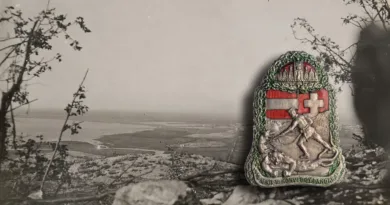November, 1914
In the year 1914, the front in Galicia was still on the move. The Austro-Hungarian and Russian offensives have switched. The aim of all of them was to achieve large territorial gains that would permanently bring the opponent to his knees. The Russian steamroller started again in November to take Krakow. After this Russians could turn south to threaten Silesia, Moravia, potentially even Vienna. Hungarian troops played an important role in fending off this great Russian attack in November and December. North of Krakow, the Russians threatened to encircle the city. Their troops had already overran Krakow in a westerly direction and turned south to get into the back of the defense of the 1 Army. The 37th Division was tasked with retaking the town of Jangrot north of Krakow, around which the Russians deployed large forces.

In front of Jangrot, a 60-metre-high, completely steep mountain formed the safe position of the Russians, from which the view was wide open. A frontal attack on the rock seemed hardly possible. The division’s repeated attacks didn’t succeed for two days. Therefore, two battalions of the 15th Honvéd Regiment of Trencsén were made available to the attacking brigade. But they could not advance either. Finally, the last reserve, the III battalion was ordered to move the attack forward immediately. In view of the difficult terrain, Major Pál Szakál, battalion commander, decided to carry out the order with some modification. He intended to use not only his own battalion. Instead he withdrew, settled the entire regiment, and planned to occupy Jangrot with a surprise night attack. The entire regiment formed a dense line on both sides of the road leading to Jangrot. The 14th Regiment to the left and the 72nd regular infantry to the right were invited to participate in the seizure.
At 5:30 a.m., the regiment was ready to attack 300 meters away from the Russians. At this moment, the regimental command had just received an order to go back instead of the seizure. The entire division would attack on the next day. Despite this, Major Szakál, ordered the attack at 6:30. The attack was magnificent and went on with very few losses. After a brief dogfight with the Russians, they surrendered in groups. The regiment then invaded the occupied line and turned it for defense. 350 POWs and three machine guns were sent back and a lot of war equipment was seized. Major Pál Szakál, who designed the attack on his own initiative and carried out it against orders, was awarded the Golden Bravery Medal. The 15th Regiment of Trencsén started to celebrate the anniversary as a regiment memorial day.

The Kappenabzeichen of the 15th Honvéd lists the Jangrot event on first place. Interestingly, there is another badge of the 71st regiment on the post card that also mentions Jangrot. It is the card of the Comrade Organization of the regiments of Trencsén (15th and 71st regiments) from the 1930s. The depicted badge of the 71th regiment must have existed. Yet, I have never seen it anywhere.




